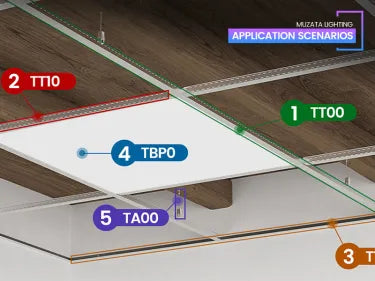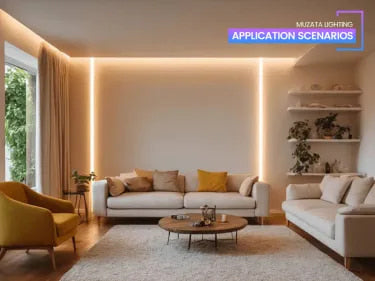TABLE OF CONTENTS
Bright Ideas: A Detailed Guide to LED Hanging Lighting
Welcome to the world of LED hanging lighting, where functionality meets elegance. Imagine transforming your home with lighting that not only illuminates but also adds a touch of sophistication. Today, let’s dive into a detailed guide on LED hanging lights and discover why they’re becoming a favorite choice for homeowners and designers alike.
Why LED Hanging Lights?

So, what’s the big deal with LED hanging lights? Are they really that different from other lighting options?
Absolutely! LED hanging lights are more than just a source of illumination. They offer versatility, energy efficiency, and a modern aesthetic that traditional lighting options can’t match. Unlike incandescent or fluorescent lights, LEDs are designed to be both functional and stylish, making them suitable for a wide range of settings, from residential to commercial spaces.
Versatility That Fits Every Space
Can they be used anywhere?
That’s the beauty of LED hanging lights. They come in various shapes, sizes, and styles to suit any room in your home.
-
Kitchen
In the kitchen, consider using LED pendant lights over an island. These provide focused task lighting, essential for cooking and food preparation. For example, a set of three pendant lights, each with a brightness of 800 lumens, can adequately light up a standard kitchen island.

-
Dining Room
An LED chandelier in the dining room can add elegance and sophistication. A fixture with adjustable brightness, ranging from 1,500 to 3,000 lumens, can create the perfect ambiance for both casual meals and formal dinners.

-
Living Room
In the living room, a statement LED hanging light can serve as a focal point. A fixture with a warm color temperature (2700K to 3000K) can create a cozy and inviting atmosphere.

Energy Efficiency and Savings
How does that work make they’re energy-efficient?
LED lights use significantly less energy than traditional incandescent bulbs, which translates to lower electricity bills. Here’s a more detailed breakdown:
-
Energy Consumption
A 60-watt incandescent bulb produces about 800 lumens, whereas an LED bulb produces the same amount of light using only 10 watts. This means LEDs use about 85% less energy.
-
Cost Savings
Over a year, running a 60-watt incandescent bulb for 5 hours a day would cost approximately $11 (based on an average electricity rate of $0.12 per kWh). In comparison, an equivalent 10-watt LED bulb would cost only about $1.83. If you replace 20 bulbs in your home with LEDs, you could save around $182 annually.
Setting the Right Mood
What about the ambiance? Can LEDs create a cozy atmosphere?
Absolutely! LED hanging lights are highly customizable, allowing you to set the perfect mood for any occasion.
-
Dimmable Lights
Many LED hanging lights come with dimmable features. By installing a compatible dimmer switch, you can adjust the light intensity to create the desired ambiance. For instance, in a dining room, you can dim the lights to create a more intimate setting for dinner parties.
-
Color Temperature
LED lights are available in various color temperatures, measured in Kelvin (K). Warm white LEDs (2700K to 3000K) emit a soft, yellowish light, ideal for creating a cozy atmosphere in living rooms and bedrooms. Cool white LEDs (4000K to 5000K) provide a bright, white light, suitable for kitchens and bathrooms where task lighting is important.
Easy Installation and Smart Features
How hard is it to install these lights?
Most modern LED hanging lights are designed for easy installation, often requiring just a few tools and some basic DIY skills. Here’s a step-by-step guide:
- Turn Off Power: Always start by turning off the power at the circuit breaker to avoid any electrical hazards.
- Prepare the Mounting Surface: Use a stud finder to locate the ceiling joists, ensuring the fixture is securely attached. Mark the spots where you’ll install the mounting brackets.
- Install the Mounting Bracket: Attach the mounting bracket to the ceiling using screws. Make sure it’s level and secure.
- Connect the Wiring: Connect the wires from the fixture to the corresponding wires in the ceiling using wire nuts. Typically, this involves connecting the black (hot) wire to the black wire, the white (neutral) wire to the white wire, and the green or copper (ground) wire to the ground wire.
- Attach the Fixture: Secure the LED hanging light fixture to the mounting bracket. Ensure all connections are tight and the fixture is stable.
- Test the Light: Turn the power back on at the circuit breaker and test the light to make sure it’s working properly.
Addressing Common Concerns
Are they really bright enough?
Definitely. LEDs are known for their high lumen output, providing ample brightness while using less power. Here’s what you need to know:
-
Brightness
LEDs are measured in lumens, not watts. For example, a 10-watt LED bulb can produce the same brightness (800 lumens) as a 60-watt incandescent bulb. This means you can achieve the desired level of brightness with much lower energy consumption.
-
Coverage
The design of hanging lights helps distribute light evenly, ensuring no dark corners. For example, a multi-light pendant with adjustable arms can spread light across a wider area, making it suitable for larger rooms.
Will they match my home decor?
With the vast range of styles available, you’re sure to find something that fits your decor. Here are some tips:
-
Style
Choose a style that complements your existing decor. For a modern look, opt for sleek, minimalistic designs. For a more traditional feel, consider ornate fixtures with classic finishes.

-
Finish
Pay attention to the finish of the light fixture. Popular finishes include brushed nickel, matte black, and antique bronze. Match the finish with other elements in your room, such as cabinet hardware or furniture legs, for a cohesive look.
-
Adjustability
Many LED hanging lights come with adjustable hanging lengths, making them suitable for rooms with varying ceiling heights. This ensures the fixture is at the perfect height for both functionality and aesthetics.
Making the Right Choice
How do I choose the right LED hanging light for my space?
Start by considering the purpose of the room and the type of lighting you need:
- Task Lighting: For areas where you need focused, bright light, such as kitchens and home offices, choose LED hanging lights with higher lumen output and cooler color temperatures.
- Ambient Lighting: For general lighting in living rooms, bedrooms, and dining areas, opt for fixtures with lower lumen output and warmer color temperatures to create a cozy atmosphere.
- Accent Lighting: Use LED hanging lights to highlight specific areas or features in a room, such as a piece of artwork or a seating area. Look for fixtures with adjustable arms or directional lighting capabilities.
Conclusion
This all sounds great. Where do you start?
Begin by assessing your needs and exploring different styles. Think about the ambiance you want to create and the functionality you need. Once you find the perfect LED hanging light, you’ll see how transformative good lighting can be. It’s not just about illumination; it’s about creating a beautiful, inviting space that feels like home.
Are you ready to light up your life with LED hanging lights? Let’s make your home shine!




